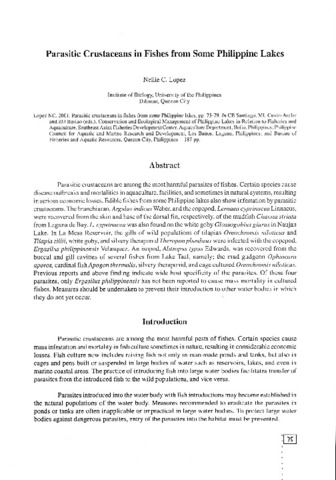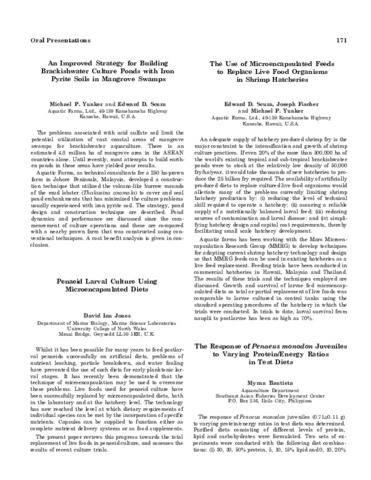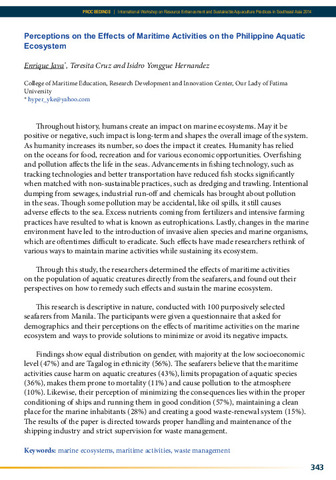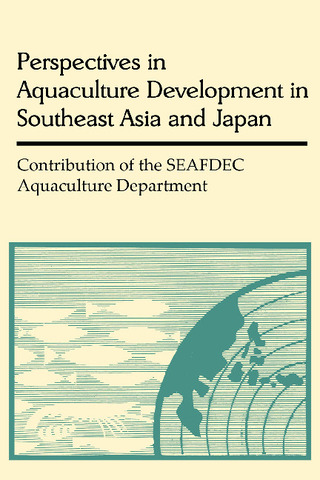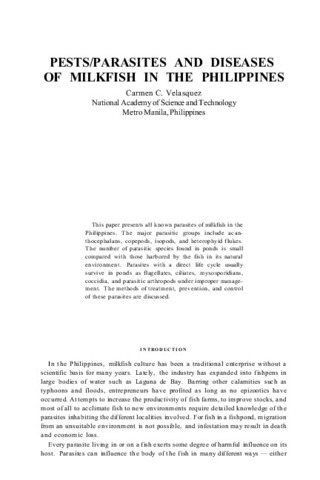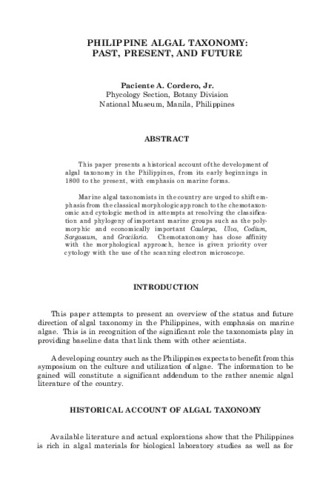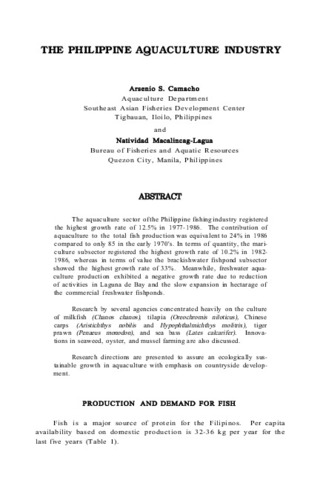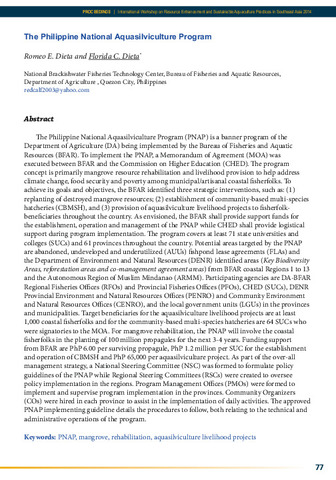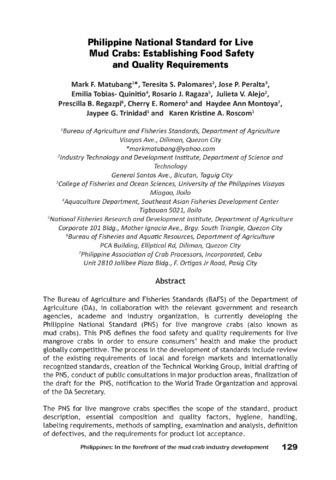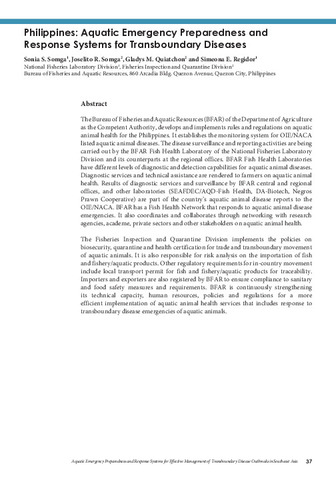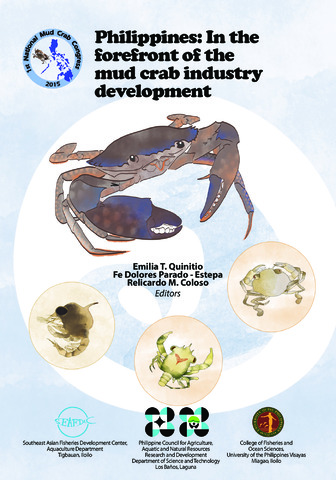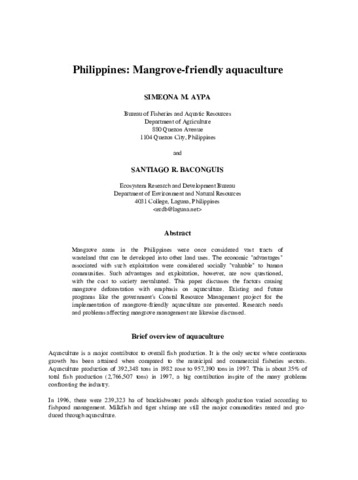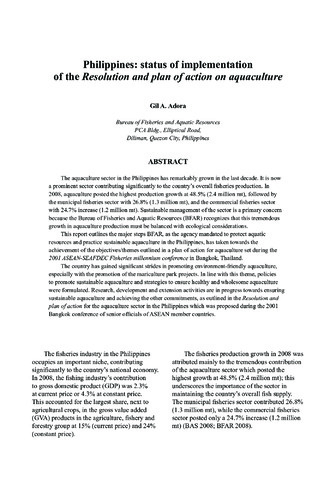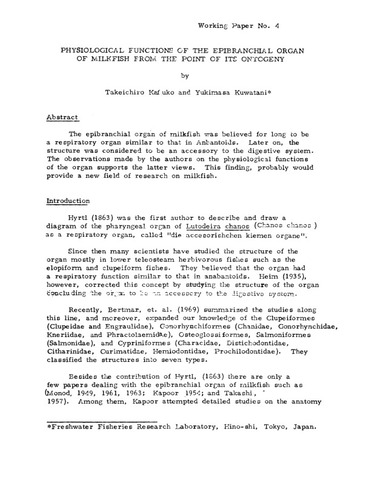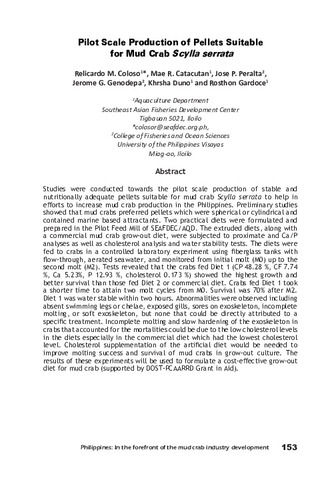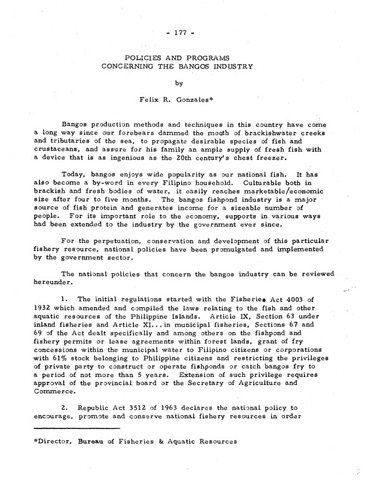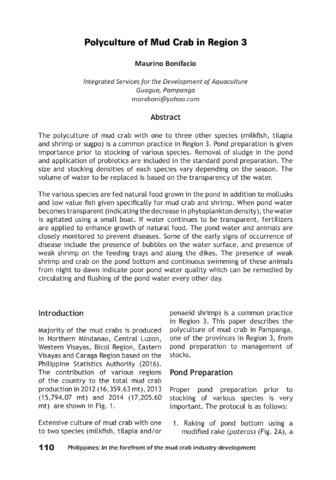Mencari Conference Proceedings berdasarkan Judul
Now showing items 455-474 of 767
-
Parasitic crustaceans in fishes from some Philippine Lakes
(Aquaculture Department, Southeast Asian Fisheries Development Center; Philippine Council for Aquatic and Marine Research and Development (PCAMRD), Department of Science and Technology; Bureau of Fisheries and Aquatic Resources, 2001)Parasitic crustaceans are among the most harmful parasites of fishes. Certain species cause disease outbreaks and mortalities in aquaculture, facilities, and sometimes in natural systems, resulting in serious economic ... -
Pasig River backflow and its effect on the water quality of Laguna de Bay, Philippines
(Aquaculture Department, Southeast Asian Fisheries Development Center; Philippine Council for Aquatic and Marine Research and Development (PCAMRD), Department of Science and Technology; Bureau of Fisheries and Aquatic Resources, 2001)The backflow of Pasig River into Laguna de Bay was closely monitored beginning April 28, 1997 based on the expected high tide in Manila Bay and the average low lake level of 2.5 m in Station W (N 14°27.7'; E 121°08.5') ... -
Penaeid larval culture using microencapsulated diets
(Aquaculture Department, Southeast Asian Fisheries Development Center, 1985)Whilst it has been possible for many years to feed postlar-val penaeids successfully on artificial diets, problems of nutrient leaching, particle breakdown, and water fouling have prevented the use of such diets for early ... -
Perceptions on the effects of maritime activities on the Philippine aquatic ecosystem
(Aquaculture Department, Southeast Asian Fisheries Development Center, 2015)Throughout history, humans create an impact on marine ecosystems. May it be positive or negative, such impact is long-term and shapes the overall image of the system. As humanity increases its number, so does the impact ... -
Perspectives in aquaculture development in Southeast Asia and Japan: Proceedings of the Seminar on Aquaculture Development in Southeast Asia, Iloilo City, Philippines, 8-12 September 1987
(Aquaculture Department, Southeast Asian Fisheries Development Center, 1988)This proceedings is a comprehensive account of the seminar and contains the papers read and discussed at the sessions, and the recommendations reached and formulated. -
Pest/parasites and diseases of milkfish in the Philippines
(Aquaculture Department, Southeast Asian Fisheries Development Center, 1979) -
Pests/parasites and diseases of milkfish in the Philippines
(Aquaculture Department, Southeast Asian Fisheries Development Center; International Development Research Centre; Island Publishing House, Inc., 1984)This paper presents all known parasites of milkfish (Chanos chanos ) in the Philippines. The major parasitic groups include acanthocephalans, copepods, isopods, and heterophyid flukes. The number of parasitic species found ... -
Philippine algal taxonomy: Past, present, and future
(Aquaculture Department, Southeast Asian Fisheries Development Center, 1990)This paper presents a historical account of the development of algal taxonomy in the Philippines, from its early beginnings in 1800 to the present, with emphasis on marine forms. Marine algal taxonomists in the country ... -
The Philippine aquaculture industry
(Aquaculture Department, Southeast Asian Fisheries Development Center, 1988)The aquaculture sector of the Philippine fishing industry registered the highest growth rate of 12.5% in 1977-1986. The contribution of aquaculture to the total fish production was equivalent to 24% in 1986 compared to ... -
The Philippine National Aquasilviculture Program
(Aquaculture Department, Southeast Asian Fisheries Development Center, 2015)The Philippine National Aquasilviculture Program (PNAP) is a banner program of the Department of Agriculture (DA) being implemented by the Bureau of Fisheries and Aquatic Resources (BFAR). To implement the PNAP, a Memorandum ... -
Philippine National Standard for Live Mud Crabs: establishing food safety and quality requirements
(Aquaculture Department, Southeast Asian Fisheries Development Center, 2017)The Bureau of Agriculture and Fisheries Standards (BAFS) of the Department of Agriculture (DA), in collaboration with the relevant government and research agencies, academe and industry organization, is currently developing ... -
Philippines: Aquatic emergency preparedness and response systems for transboundary diseases
(Aquaculture Department, Southeast Asian Fisheries Development Center, 2019)The Bureau of Fisheries and Aquatic Resources (BFAR) of the Department of Agriculture as the Competent Authority, develops and implements rules and regulations on aquatic animal health for the Philippines. It establishes ... -
Philippines: In the forefront of the mud crab industry: Proceedings of the 1st National Mud Crab Congress
(Aquaculture Department, Southeast Asian Fisheries Development Center, 2017) -
Philippines: Mangrove-friendly aquaculture
(Aquaculture Department, Southeast Asian Fisheries Development Center, 2000)Mangrove areas in the Philippines were once considered vast tracts of wasteland that can be developed into other land uses. The economic "advantages" associated with such exploitation were considered socially "valuable" ... -
Philippines: Status of implementation of the resolution and plan of action on aquaculture.
(Aquaculture Department, Southeast Asian Fisheries Development Center, 2011)The aquaculture sector in the Philippines has remarkably grown in the last decade. It is now a prominent sector contributing significantly to the country s overall fisheries production. In 2008, aquaculture posted the ... -
Physiological functions of the epibranchial organ of milkfish from the point of its ontogeny
(Aquaculture Department, Southeast Asian Fisheries Development Center, 1976)The epibranchial organ of milkfish was believed for long to be a respiratory organ similar to that in Anabantoids. Later on, the structure was considered to be an accessory to the digestive system. The observations made ... -
Pilot scale production of pellets suitable for mud crab Scylla serrata
(Aquaculture Department, Southeast Asian Fisheries Development Center, 2017)Studies were conducted towards the pilot scale production of stable and nutritionally adequate pellets suitable for mud crab Scylla serrata to help in efforts to increase mud crab production in the Philippines. Preliminary ... -
Policies/financing
(Aquaculture Department, Southeast Asian Fisheries Development Center, 1984)The paper discussed briefly Philippine Government policies on aquaculture. It emphasized the value of conservation to promote ecological stability of our natural resources. Mentioned were the steps the government has done ... -
Polyculture of mud crab in Region 3
(Aquaculture Department, Southeast Asian Fisheries Development Center, 2017)The polyculture of mud crab with one to three other species (milkfish (Chanos chanos), tilapia (Oreochromis spp.) and shrimp or sugpo (Penaeus monodon)) is a common practice in Region 3. Pond preparation is given importance ...

